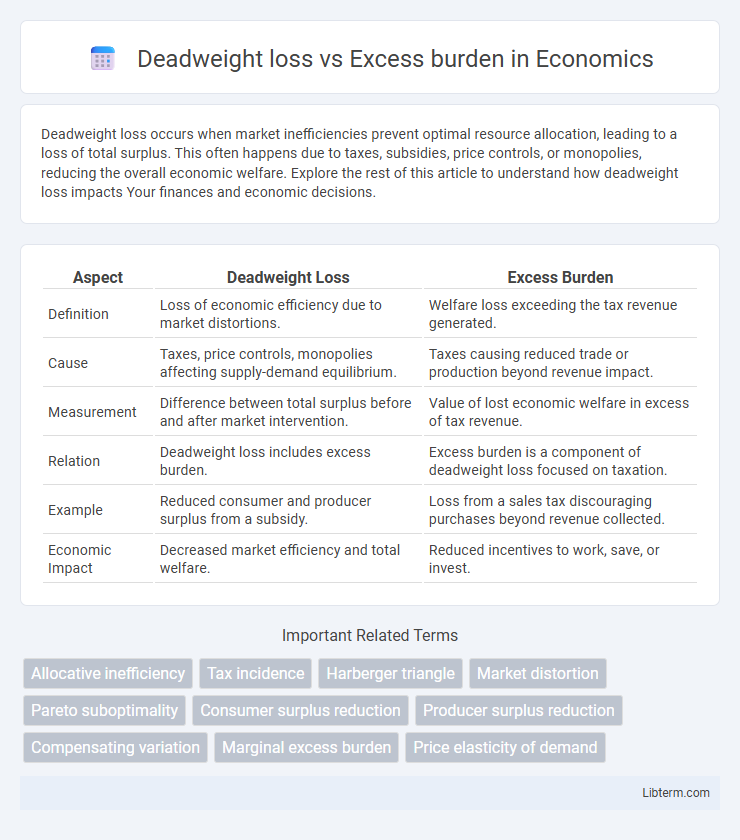Deadweight loss occurs when market inefficiencies prevent optimal resource allocation, leading to a loss of total surplus. This often happens due to taxes, subsidies, price controls, or monopolies, reducing the overall economic welfare. Explore the rest of this article to understand how deadweight loss impacts Your finances and economic decisions.
Table of Comparison
| Aspect | Deadweight Loss | Excess Burden |
|---|---|---|
| Definition | Loss of economic efficiency due to market distortions. | Welfare loss exceeding the tax revenue generated. |
| Cause | Taxes, price controls, monopolies affecting supply-demand equilibrium. | Taxes causing reduced trade or production beyond revenue impact. |
| Measurement | Difference between total surplus before and after market intervention. | Value of lost economic welfare in excess of tax revenue. |
| Relation | Deadweight loss includes excess burden. | Excess burden is a component of deadweight loss focused on taxation. |
| Example | Reduced consumer and producer surplus from a subsidy. | Loss from a sales tax discouraging purchases beyond revenue collected. |
| Economic Impact | Decreased market efficiency and total welfare. | Reduced incentives to work, save, or invest. |
Understanding Deadweight Loss
Deadweight loss occurs when market inefficiencies cause a loss of economic surplus, typically resulting from taxes or price controls that reduce the quantity of traded goods below the efficient market equilibrium. Unlike excess burden, which is the broader economic cost of taxation including behavioral changes, deadweight loss specifically quantifies the lost gains from trade that neither consumers nor producers receive. Measuring deadweight loss is crucial for evaluating the overall impact of fiscal policies on market efficiency and welfare.
Defining Excess Burden
Excess burden refers to the economic loss that exceeds the actual tax revenue collected, caused by distortions in consumer and producer behavior due to taxation. It represents inefficiency introduced in the market, as resources are allocated suboptimally compared to a no-tax scenario. Deadweight loss is a component of excess burden, specifically the loss in total surplus resulting directly from reduced trade or production.
Economic Origins of Deadweight Loss
Deadweight loss originates from market inefficiencies such as taxes, subsidies, or price controls that prevent optimal resource allocation, causing a loss of total welfare. Excess burden specifically refers to the economic cost imposed by taxation beyond the actual tax revenue, reflecting the distortion in consumer and producer behavior. Both concepts highlight the economic origins rooted in distortions that reduce net social surplus and create inefficiencies in the market.
Causes of Excess Burden in Markets
Excess burden in markets primarily arises from distortions caused by taxes, subsidies, or price controls that disrupt the efficient allocation of resources. When taxes alter consumers' and producers' behavior by changing prices and quantities exchanged, this leads to a reduction in total economic surplus beyond the tax revenue collected, causing deadweight loss. Factors such as high tax rates, inelastic supply and demand, and limited market flexibility exacerbate the excess burden by amplifying inefficiencies and reducing market welfare.
Mathematical Representation of Deadweight Loss
Deadweight loss is mathematically represented as the area of the triangle formed between the supply and demand curves around the equilibrium point after a tax or subsidy is imposed, calculated as \( \frac{1}{2} \times \text{Tax} \times \text{Change in Quantity} \). Excess burden refers to the inefficiency created by a tax that causes resources to be allocated suboptimally, often quantified by the difference between total welfare loss and the tax revenue collected. The mathematical representation of deadweight loss emphasizes the distortion in trade-offs and the resulting loss of economic welfare.
Measuring Excess Burden: Key Indicators
Measuring excess burden involves evaluating the economic inefficiency caused by taxation beyond the actual tax revenue, often quantified through deadweight loss. Key indicators include changes in consumer surplus, producer surplus, and overall market equilibrium distortions, reflecting the loss in total welfare. Empirical analysis frequently employs elasticity of supply and demand to estimate how taxes distort market behavior, providing a direct measure of excess burden relative to deadweight loss.
Policy Implications: Deadweight Loss vs Excess Burden
Deadweight loss represents the total economic inefficiency caused by market distortions such as taxes or subsidies, while excess burden specifically measures the loss in consumer and producer surplus beyond the revenue generated by the tax. Policymakers must consider excess burden to design tax systems that minimize economic distortions and allocate resources more efficiently. Understanding the difference informs decisions on tax rates and structures to balance revenue needs with economic welfare.
Real-World Examples of Deadweight Loss
Deadweight loss occurs when market inefficiencies lead to lost economic value, often seen in tax-induced reductions in trade, such as sales taxes decreasing consumer purchases of goods like electronics or gasoline. Excess burden exemplifies the economic cost beyond the tax revenue collected, illustrated by higher cigarette taxes causing smokers to reduce consumption and illicit trade to rise, distorting the market. Real-world cases like the U.S. excise taxes on alcohol demonstrate deadweight loss by increasing prices and reducing quantity demanded, leading to inefficiencies and loss of consumer and producer surplus.
Strategies to Minimize Excess Burden
Minimizing excess burden requires implementing efficient tax systems that reduce distortions in market behavior, such as broad-based taxes with low rates instead of highly selective taxes. Utilizing lump-sum taxes or taxes on inelastic goods can also limit the welfare loss by minimizing changes in consumer and producer decisions. Policymakers focus on improving tax design and administrative efficiency to ensure revenue goals are met with the least impact on economic incentives and resource allocation.
Deadweight Loss and Excess Burden: Comparative Analysis
Deadweight loss refers to the reduction in total economic surplus caused by market inefficiencies, often resulting from taxes, subsidies, or price controls that prevent optimal allocation of resources. Excess burden measures the additional cost to society beyond the tax revenue generated, reflecting the efficiency loss due to behavioral changes in consumption or production. Comparative analysis reveals that while deadweight loss quantifies overall welfare loss, excess burden specifically captures the distortionary effect of taxation on market decisions.
Deadweight loss Infographic

 libterm.com
libterm.com